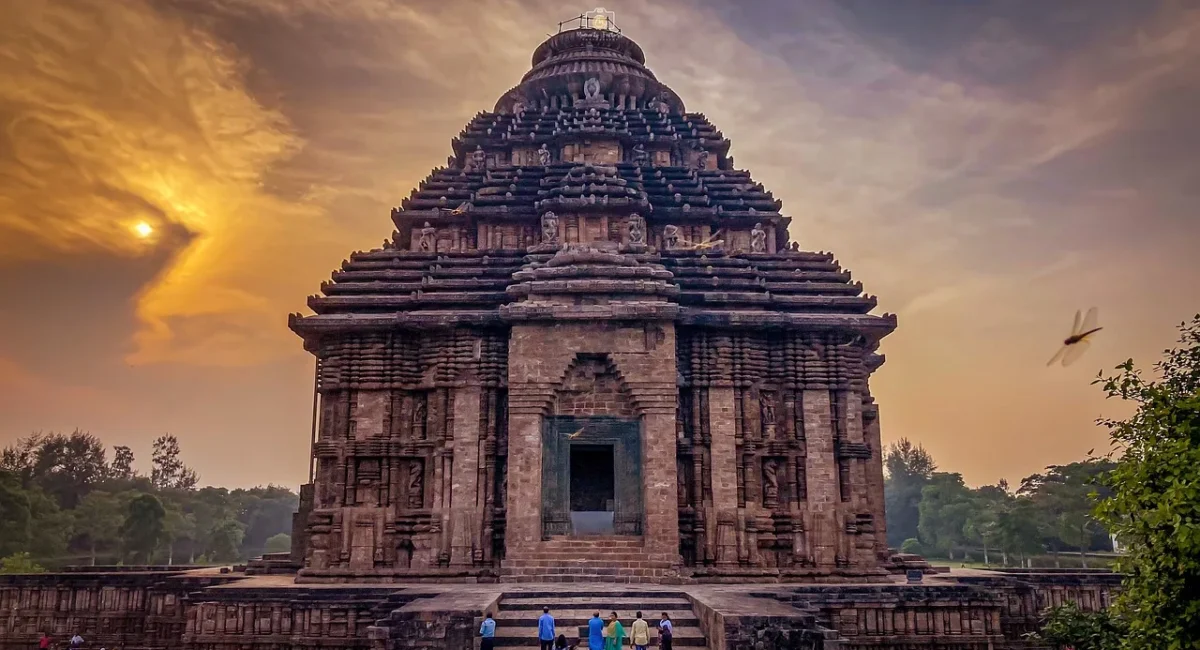Konark Sun Temple – UNESCO World Heritage Site | History, Architecture & Travel Guide
1. Introduction to Konark Sun Temple
The Konark Sun Temple, a UNESCO World Heritage Site located in Odisha, India, is one of the most magnificent examples of ancient Indian architecture. Often referred to as the “Black Pagoda” by European sailors due to its dark stone façade, this 13th-century temple is dedicated to Surya, the Hindu Sun God. Designed as a colossal chariot with 24 intricately carved wheels, pulled by seven horses, Konark stands as a fusion of art, science, and spirituality.
Why Konark Matters
- UNESCO Recognition: Declared a World Heritage Site in 1984 for its cultural and historical significance.
- Architectural Wonder: Represents the pinnacle of Kalinga architecture, blending Nagara and Dravidian styles.
- Scientific Precision: The temple’s alignment with the sun and its sundial-like wheels showcase ancient India’s astronomical knowledge.
Historical Background and Legends
The Mythological Roots
The temple’s origins are steeped in Hindu mythology. According to the Bhavishya Purana, Lord Krishna’s son Samba was cursed with leprosy for mocking the sage Narada. After 12 years of penance at Mitravana (Konark’s ancient name), Samba built a Sun Temple ( Konark Sun Temple ) to honor Surya, who cured him. This legend inspired King Narasimhadeva I to construct the current temple in the 13th century.
The Historical Timeline
- King Narasimhadeva I (1238–1250 CE): The Eastern Ganga Dynasty ruler commissioned the temple to commemorate his victory over Muslim invaders.
- Construction Challenges: Over 1,200 artisans worked for 12 years, using advanced engineering techniques to erect the 229-foot-tall structure.
- Decline: By the 16th century, the temple’s main sanctum collapsed due to structural instability, possibly accelerated by the removal of a central lodestone.
The Tragic Legend of Dharmapada
A poignant Odia folktale narrates how the temple’s chief architect, Bisu Maharana, struggled to complete the pinnacle. His 12-year-old son Dharmapada solved the engineering puzzle but sacrificed himself by leaping into the sea to avoid accusations of divine interference.
Architectural Design: The Stone Chariot
The Chariot Concept
The temple is designed as Surya’s celestial chariot:
- 24 Wheels: Each 12-foot-high wheel symbolizes 24 hours of the day or the 24 Hindu puranas. The 8 spokes represent the 8 praharas (3-hour divisions of a day).
- 7 Horses: Symbolize the days of the week or the 7 colors of sunlight.
- Three-Tiered Structure: Originally comprising the Vimana (sanctum), Jagamohana (assembly hall), and Natya Mandapa (dance hall), only the latter two remain intact.
Materials and Craftsmanship
- Stone Selection: Chlorite, laterite, and khondalite stones were transported from quarries via the Chandrabhaga River.
- Interlocking Technique: Stones were carved to fit together without mortar, a method still studied by engineers today.
The Magnetic Mystery
European accounts from the 17th century mention a giant lodestone at the temple’s peak, which allegedly caused the idol of Surya to levitate. The stone’s removal by sailors purportedly destabilized the structure, leading to its collapse.
Engineering Marvels and Construction Techniques
Solar Alignment and Astronomical Genius
- Sunrise Spectacle: The temple’s east-west axis ensures that the first rays of dawn strike the main entrance, illuminating the sanctum.
- Wheels as Sundials: Each wheel’s spokes cast shadows that act as precise timekeepers.
The Lost Sanctum
The original Vimana (sanctum) stood 229 feet tall but collapsed due to:
- Soil Subsidence: The soft riverine soil couldn’t support the weight.
- Magnet Theory: Removal of the lodestone disrupted the balance.
Advanced Drainage Systems
Hidden channels and grooves in the stonework diverted rainwater, preventing erosion—a feature absent in many modern structures.
Symbolism and Iconography
Cosmic Symbolism
- Chariot as a Cosmic Cycle: Represents the sun’s journey across the sky, reinforcing Hindu beliefs in cyclical time.
- Erotic Sculptures: Over 200 erotic carvings (mithunas) reflect Tantric philosophies, symbolizing the union of Shiva and Shakti.
Depictions of Daily Life
Panels showcase medieval Odisha’s society:
- Royal Processions: Kings, elephants, and warriors in battle.
- Trade and Commerce: Merchants, ships, and foreign traders.
- Music and Dance: Musicians playing the mridangam and dancers in Odissi poses.
Cultural and Religious Significance
A Pilgrimage Destination
Konark formed part of the “Golden Triangle” with Puri’s Jagannath Temple and Bhubaneswar’s Lingaraj Temple. Though worship ceased after the 16th century, the site remains spiritually significant.
Festivals and Celebrations
- Chandrabhaga Mela: Held in February, thousands gather to bathe in the Chandrabhaga River, echoing ancient rituals.
- Konark Dance Festival: A week-long celebration of classical dance forms against the temple’s backdrop.
Decline and Preservation Efforts
Causes of Deterioration
- Coastal Erosion: The temple’s proximity to the Bay of Bengal accelerates saltwater damage.
- Vegetation Growth: Roots from nearby trees have cracked stonework.
Conservation Initiatives
- ASI Interventions: The Archaeological Survey of India uses lime mortar and chemical treatments to stabilize carvings.
- UNESCO’s Role: Funding and expertise for laser cleaning and 3D documentation.
Visitor’s Guide: Planning Your Trip to Konark Sun Temple
Best Time to Visit Konark Sun Temple
- October–March: Cool, dry weather ideal for exploration.
- Sunrise/Sunset: Capture the temple’s golden hues.
How to Reach Konark Sun Temple
- By Air: Biju Patnaik Airport (Bhubaneswar) is 60 km away.
- By Train: Puri Railway Station (35 km) connects to major cities.
Timings of Konark Sun Temple
- Open: 6:00 AM – 8:00 PM daily
Nearby Attractions from Konark Sun Temple
- Puri Jagannath Temple: 35 km away.
- Raghurajpur Artist Village: A heritage crafts hub.
Konark’s Influence on Modern Culture
- Architectural Inspiration: Delhi’s Lotus Temple and Konark Wheel at Parliament House.
- Currency and Stamps: The temple’s wheel features on India’s ₹10 note.
- Literature and Film: Documentaries like The Sun Temple of Konark (1986) and poems by Rabindranath Tagore.


Leave a Comment